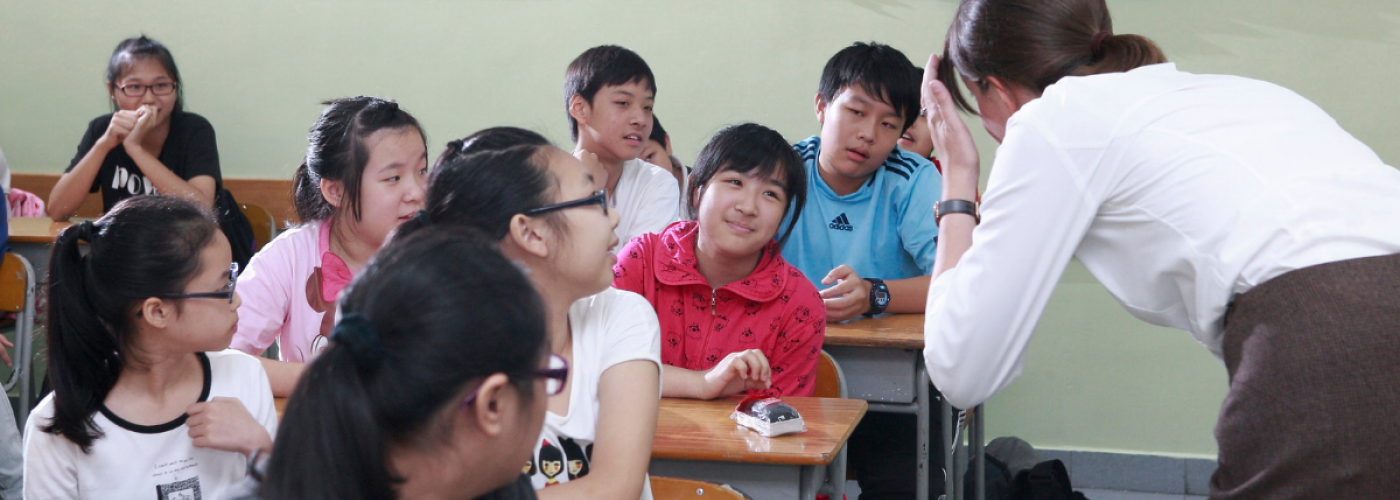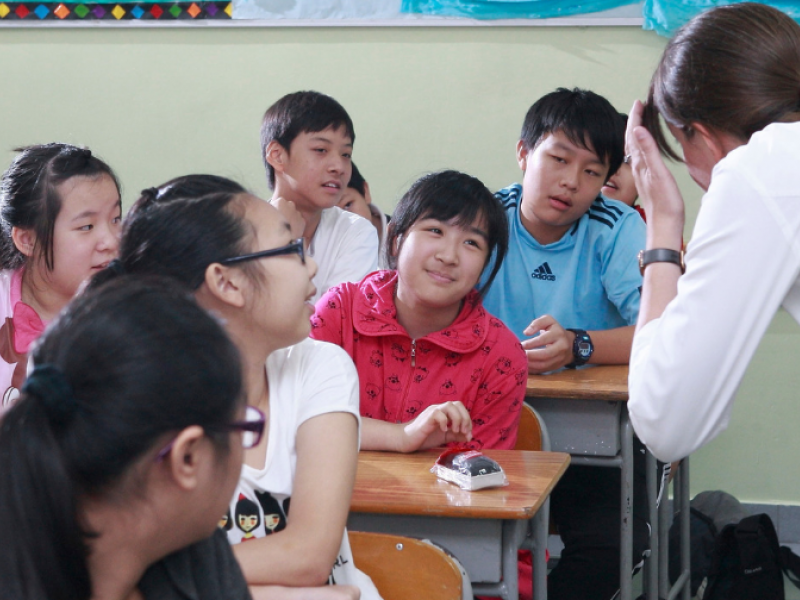8th October 2018
When planning to teach a language item, how can you ensure that your learners are getting what they need at key points in the lesson? The way in which teaching and learning activity, tasks and activities are ordered can go a long way to helping students to achieve within the limited time they have and with the content you are teaching. The PPP lesson staging technique is well-known and has become a standard of the ESOL classroom, but teachers do not always include the micro-stages and routines which really make PPP work in a purposeful way.
The three stages of a PPP lesson (Present – Practice – Produce) are useful for lessons focusing on a language system (grammar, vocabulary or pronunciation). This structure is useful for introducing a language point to learners with very little experience of the item, and guides them towards independent production of the language they are learning in a scaffolded way. The three main stages of the lesson are:
Presentation – Elicitation, drilling and concept checking
Presentation, where the teacher elicits, drills and checks key aspects of meaning and use, provides a comprehensive first appreciation of the language being taught. In an effective presentation stage, the teacher should introduce new language by focusing on meaning before form. This means eliciting the target language through visual aids, gestures or video along with simple questions which do not contain the form being taught, but build up to its meaning. This takes some planning, but by fixing the concept of the language independently of the form itself, you can ensure that students have a correct understanding of exactly what it means (and doesn’t mean), before making contact with the language itself.
For example, when introducing the past continuous tense, you could show a picture of a street scene where lots of things are happening, and elicit the form by saying: “this is what I saw out of my window yesterday morning. Tell me about what I saw”. The natural answer to this prompt is “some people were walking / a man was waiting for a bus, etc.”. If this is a relatively new piece of grammar for the learners, the question “what were these people doing yesterday morning?” is not a good question – if that is the grammar you are teaching, then you are assuming that the learners do not fully understand it (otherwise why are you teaching it?). By using the language you are teaching to elicit the same language, you are setting the learners up for failure from their very first contact with the form. This is simply unfair and will lead to problems later on.
Presentation of new language should also focus on pronunciation, after all, you want your students to use the new form, so it is worth highlighting how to say it. Drilling is an effective way to achieve this, but drilling is often not well thought through by language teachers. Be aware that fixing correct pronunciation in every member of the class takes more than simply calling out the word and asking the whole class to repeat after you. How can you hear individual problems among a chorus of 30 voices all speaking together? Ask the whole class to repeat after you at first, to give everyone the confidence that comes with trying a new word out in a group, then call on small groups or pairs of students to say the form, then focus on individuals who may need support. Correct any mispronunciations now, and students will focus more on the spoken form later in the lesson.
When (and only when) you are happy that students are producing mostly correct forms, turn to the written form of the language you are teaching. Focusing on spelling too early can cause problems with pronunciation, as irregular spellings and contractions can be mispronounced easily, so save your whiteboard display of the form until after a good drilling session. Where possible, write a marker sentence which contains the word or grammar you are teaching to show the form in context, and you can demonstrate usage points at the same time.
Finally, an important and often forgotten part of language presentation is concept checking. Refer students to the form that you want to check, and ask a series of very simple yes-or-no questions to isolate the correct meaning of what you have taught. This confirms how strongly your learners have taken on the meaning of the word, and allows them to demonstrate their comprehension in a simple way. This is important for you, as you need to know what they have and haven’t picked up, to inform how you deal with later tasks in the lesson.
Going back to the past continuous tense, concept checking questions (CCQs) could include “is the action happening in the past?”, “Did you see the people start the actions?”, “Did you see the people finish the actions?”. The three answers to these questions (Yes, no and no) will show you that students have correctly understood the concept behind the past continuous.
Presentation is probably the most detailed and procedural stage of a PPP lesson, and should take about a quarter of your lesson time. Once you have checked student understanding, they are ready to move on to some tasks to get working with the language.
Practice tasks and feedback
Effective language practice does not simply mean getting the students using the language they are learning; it should include restricted elements of use to focus on specific aspects of meaning and form. Restricted practice tasks should prompt students to make choices about what language they use to answer questions. Common question types are gapfill, sentence completion and matching sentence halves, or words and pictures. At this point in the lesson, students should be thinking “is this the correct form, or that one?”, then deciding on an answer based on information which appears in the sentence example, or in the task itself. Writing complete sentences, or using the new form freely is too much too soon at this point, as learners will typically need some support early on in their application of new language.
After you have set the task and students have finished writing their ideas, lead a session where they can suggest answers to you and the rest of the class for comment. This is the all-important post-task feedback stage. Allow time for individual students (nominated by you) to think and give a considered answer, if possible showing why they chose that word or phrase in that situation. Whether they give an accurate response or not, the confidence to speak out and share an answer deserves praise, and should be opened up to other students for comment. Be careful of stepping on a correct answer too soon and confirming it – too much teacher input here will switch students off to other possible answers, and they will end up listening to you rather than each other, which shuts down the possibility for discussion or peer correction, an important part of communicative language learning. Practice task feedback is where the bulk of the real learning, rethinking and confirmation of the form in use happens, so do not neglect it for the sake of a few minutes of lesson time.
Production tasks and final feedback
Once you are happy that students have mostly got their ideas straight in the restricted task, they are ready to fly a little freer without so much support from you. This is the essence of a scaffolded approach to teaching – withdrawing your support throughout the lesson to enable learners to finally apply what you are teaching in their own extended ideas. Production tasks are usually freer speaking or writing activities, where students produce language without much support from a task, to talk on a topic or write a piece to a prompt which would naturally be fulfilled by using the target form you have taught. For example, a present continuous production task could ask students to describe some of the things they saw on the way to school, or the strangest thing they have ever seen out of their bedroom window. These prompts use the same basic concept as your elicitation prompts from the presentation stage, but personalised so that students can really talk about their own experiences. Be aware that students often need to be reminded of the key aspects of meaning that you ran through before (remember, describe things that you did not see the beginning or end of, but things you saw going on as you looked…). A really focused production task (if you have time) is made possible with some brainstorming of ideas or planning of vocabulary that the learners will need for their story. Use a four-minute dictionary stage or reflective time to gather ideas, then ask students to speak or write, and usually the end result is more comprehensive and accurate.
The post-task feedback stage for a final production activity is less in-depth and accuracy focused than that of a practice stage. At this point, students have demonstrated the final outcome of the lesson (unless you ask them to perform a second production stage even better than the first), so use this time to refer to some successful and unsuccessful moments that you heard in your learners’ language. Display a couple of nice examples of usage, or funny sentences that you heard, and offer some final advice on the use of the form that they have been working with.
The PPP lesson structure is a ‘golden oldie’ of TESOL, but as the saying goes: if it ain’t broke, don’t fix it! Used well, it is a reliable and effective procedure that gives you tangible outcomes to your lesson, evidenced by the staged learning that is made possible through the class time.
If you'd like to discover new ways to improve your lessons, come and meet some of our teacher training team by joining one of our upcoming professional development workshops conducted both online and in our Hong Kong training centre.



